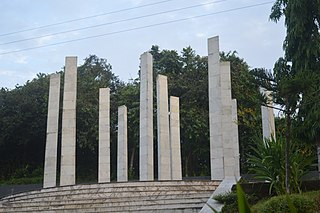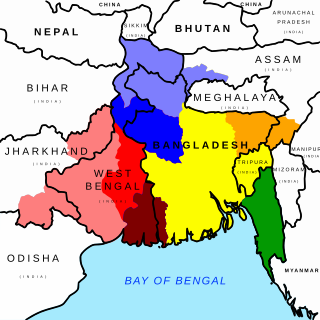Related Research Articles

Assam is a state in northeastern India, south of the eastern Himalayas along the Brahmaputra and Barak River valleys. Assam covers an area of 78,438 km2 (30,285 sq mi). It is the second largest state in northeastern India by area and the largest in terms of population, with more than 31 million inhabitants. The state is bordered by Bhutan and Arunachal Pradesh to the north; Nagaland and Manipur to the east; Meghalaya, Tripura, Mizoram and Bangladesh to the south; and West Bengal to the west via the Siliguri Corridor, a 22-kilometre-wide (14 mi) strip of land that connects the state to the rest of India. Assamese and Bodo are two of the official languages for the entire state and Meitei (Manipuri) is recognised as an additional official language in three districts of Barak Valley and Hojai district. in Hojai district and for the Barak valley region, alongside Bengali, which is also an official language in the Barak Valley.

Cachardistrict is an administrative district in the state of Assam in India. After independence, the pre-existing undivided Cachar district was split into four districts: Dima Hasao, Hailakandi, Karimganj, and the current Cachar district. Silchar is Cachar district's center of government.

Hailakandi district is one of the 33 districts of Assam state in north-eastern India. It makes up the Barak Valley alongside Cachar and Karimganj. It was constituted as a civil subdivision on 1 June 1869. Subsequently, it was upgraded to a district in 1989, when it was split from Cachar district.

Karimganj district officially renamed as Sribhumi district is one of the 35 districts of the Indian state of Assam. Karimganj is the administrative headquarters, and biggest town of the district. It is located in southern Assam and borders Tripura and the Sylhet Division of Bangladesh. It makes up the Barak Valley alongside Hailakandi and Cachar. Karimganj was previously part of the Sylhet District before the Partition of India. It became a full fledged district in 1983.

Silchar is a city and the headquarters of the Cachar district of the state of Assam, India. It is second largest city of Assam after Guwahati in terms of area, population and GDP. It is also administrative capital of Barak Valley division. It is located 343 kilometres south east of Guwahati. It was founded by Captain Thomas Fisher in 1832 when he shifted the headquarters of Cachar to Janiganj in Silchar. It earned the moniker "Island of Peace" from Indira Gandhi, the then Prime Minister of India. Silchar is the site of the world's first polo club and the first competitive polo match. In 1985, an Air India flight from Kolkata to Silchar became the world's first all-women crew flight. Silchar was a tea town and Cachar club was the meeting point for tea planters.

The Assam Movement (1979–1985) was a popular uprising in Assam, India, that demanded the Government of India detect, disenfranchise and deport illegal aliens. Led by All Assam Students Union (AASU) and All Assam Gana Sangram Parishad (AAGSP) the movement defined a six-year period of sustained civil disobedience campaigns, political instability and widespread ethnic violence. The movement ended in 1985 with the Assam Accord.

The Barak Valley is the southernmost region and administrative division of the Indian state of Assam. It is named after the Barak river. The Barak valley consists of three administrative districts of Assam namely - Cachar, Karimganj, and Hailakandi. The main and largest city is Silchar, which seats the headquarter of Cachar district and also serves as administrative divisional office of Barak valley division. The valley is bordered by Mizoram and Tripura to the south, Bangladesh and Meghalaya to the west and Manipur to the east respectively. Once North Cachar Hills was a part of Cachar district which became a subdivision in 1951 and eventually a separate district. On 1 July 1983, Karimganj district was curved out from the eponymous subdivision of Cachar district. In 1989 the subdivision of Hailakandi was upgraded into Hailakandi district.
Abdul Matlib Mazumder (1890–1980) was an Indian freedom fighter and political leader based in undivided Assam State. In 1946, when India was still under British rule, he became an MLA and also Cabinet Minister of Assam. He was one of the prominent Muslim leaders of eastern India to support Hindu-Muslim unity, opposing the partition of India on communal lines. Mazumder along with Fakhruddin Ali Ahmed became the most prominent Muslim opponents of the demand for a separate Muslim state of Pakistan, especially in the eastern part of the country.

Bengali Hindus are an ethnoreligious population who make up the majority in the Indian states of West Bengal, Tripura, Andaman and Nicobar Islands, Jharkhand, and Assam's Barak Valley region. In Bangladesh, they form the largest minority. They are adherents of Hinduism and are native to the Bengal region in the eastern part of the Indian subcontinent. Comprising about one-third of the global Bengali population, they are the largest ethnic group among Hindus. Bengali Hindus speak Bengali, which belongs to the Indo-Aryan language family and adhere to Shaktism or Vaishnavism of their native religion Hinduism with some regional deities. There are significant numbers of Bengali-speaking Hindus in different Indian states.

The Bengali Language Movement of Barak Valley was a protest against the decision of the Government of Assam to make Assamese the state's sole official language, even though most Barak Valley residents speak Bengali. About 80% of the valley's residents are ethnic Bengalis, and the Bengali population in the Barak Valley region consists of both Hindus and Muslims in about equal number, constituting the overwhelming majority of the population. There is also a substantial minority of native tribes and immigrants from other parts of India.

The Mahimal, also known as Maimal, are a Bengali Muslim community of inland fishermen predominantly indigenous to the Sylhet Division of Bangladesh and the Barak Valley in Assam, India.

Harishankar Brahma served as 19th Chief Election Commissioner of India. He is a retired I.A.S. officer of the 1975 batch of the Andhra Pradesh cadre.
The Bengali Hindu diaspora is the worldwide population of the Bengali Hindus of Indian and Bangladeshi origin.
Bongal Kheda (trans. "Drive out the Bengalis was a xenophobic movement in Assam, India, orchestrated by native Assamese job seekers which aimed to purge out non-native job competitors — primarily, middle-class Hindu Bengalis. SooAssam has long been anti-Bengali. n after the Independence of India, the Assamese Hindu middle class gained political control in Assam and tried to gain social and economic parity with their competitors, the Bengali Hindu middle class. A significant period of property damage, ethnic policing and even instances of street violence occurred in the region. The exact timeline is disputed, though many authors agree the 1960s saw a height of disruption. It was part of a broader discontent within Assam that would foreshadow the Assamese Language Movement and the anti-Bangladeshi Assam Movement.

Islam is the second largest religion after Hinduism in Assam. The Muslim population was approximately 10.68 million, constituting over 34.22% of the total population of the state as of the 2011 census, giving Assam. Islam reached the region in the 13th century and Muslims are a majority in almost eleven districts of Assam and highly concentrated in four districts. In 2021, estimations have predicted that the Muslim population in the state has reached 40%, numbering 14 million, out of total population of 35 million.
The National Register of Citizens for Assam is a registry (NRC) meant to be maintained by the Government of India for the state of Assam. It is expected to contain the names and certain relevant information for the identification of genuine Indian citizens in the state. The register for Assam was first prepared after the 1951 Census of India. Since then it was not updated until the major "updation exercise" conducted during 2013–2019, which caused numerous difficulties. In 2019, the government also declared its intention of creating such a registry for the whole of India, leading to major protests all over the country.
The Assamese Language Movement refers to a series of political activities demanding the recognition of the Assamese language as the only sole official language and medium of instruction in the educational institutions of Assam, India.
In May 1948, widespread rioting broke out in Guwahati and adjoining areas where Bengali Hindu businesses, schools and residences in general and Bengali Hindu staff of the Bengal and Assam Railway in particular were attacked. The Assamese Hindu nationalists who saw the Bengali Hindus as foreign usurpers in the territory of Assam led the attacks while Muslim League members joined them. The Bengali Hindus were looted and their properties were looted and set on fire. No Bengali-speaking Muslim was attacked, as they were seen as Na Asamiyas who had adopted Assamese language and culture and therefore assimilated in the land Assam. The Guwahati riots mark the beginning of the Bongal Kheda movement.

The Bengali Hindus are the second-largest ethno-religious group just after Assamese Hindus in Assam. As per as estimation research, around 6–7.5 million Bengali Hindus live in Assam as of 2011, majority of whom live in Barak Valley and a significant population also resides in mainland Brahmaputra Valley. The Bengali Hindus are today mostly concentrated in the Barak Valley region, and now are politically, economically and socially dominant. Assam hosts the second-largest Bengali Hindu population in India after West Bengal.
Anti-Bengali sentiment comprises negative attitudes and views on Bengalis. This sentiment is present in several parts of India: Gujarat, Bihar, Assam, and various tribal areas. etc. Issues include discrimination in inhabitation, other forms of discrimination, political reasons, government actions, anti-Bangladeshi sentiment, etc. The discriminative condition of Bengalis can be traced from Khoirabari massacre, Nellie massacre, Silapathar massacre, North Kamrup massacre, Goreswar massacre, Bongal Kheda, etc. This has led to emergence of Bengali sub-nationalism in India as a form of protest and formation of many pro-Bengali organisations in India.
References
- ↑ "Protect rights of Bengalis from Bangladesh: CPI(M)". The Hindu. Kozhikode. 10 April 2012. Retrieved 12 August 2012.
- ↑ "ভোটের মুখে কেমন আছেন আসামের বাঙালী মুসলমান-হিন্দুরা?". BBC Bangla (in Bengali). 31 March 2016.
- ↑ "Pincer attack on D-voters". The Telegraph. Kolkata. 26 March 2012. Archived from the original on 3 February 2013. Retrieved 18 August 2012.
- 1 2 3 Chowdhury, Jyotilal (August 2012). "The Dreaded List of Assam". Eastern Panorama. Shillong. Archived from the original on 17 February 2013. Retrieved 18 August 2012.
- ↑ "Deleting Assam voters on religious basis not possible: Centre tells SC". The Hindu. New Delhi. 10 August 2012. Retrieved 12 August 2012.
- 1 2 Bhattacharya, Rajeev (16 July 2005). "Assam 'D' voters in vanishing act". The Telegraph. Kolkata. Archived from the original on 4 March 2016. Retrieved 18 August 2012.
- ↑ "Rights body moves National Human Rights Commission over suicide". The Times of India . Guwahati. 12 June 2012. Archived from the original on 3 January 2013. Retrieved 12 August 2012.
- ↑ Talukdar, Sushanta (16 February 2014). "Assam's 'doubtful' voters await clearance by foreigners' tribunals". The Hindu. Retrieved 4 March 2014.
- 1 2 3 4 "Two brothers identified as Bangladeshis". The Sentinel. Guwahati. 13 July 2011.
- ↑ "'D' phobia grips Barak as Shabdakar brothers 'pushed back'". The Sentinel. Guwahati. 14 July 2011.
- ↑ "Gautam orders cell to be set in DCC for 'D' voters". The Sentinel. Guwahati. 17 July 2011.
- ↑ Jaiswal, Umanand (20 April 2012). "D-voter tussle in PM court - Assam ready with a memorandum for Singh". The Telegraph. Kolkata. Archived from the original on 3 February 2013. Retrieved 12 August 2012.
- ↑ "D voter commits suicide in Cachar". Assam Times. 10 June 2012. Archived from the original on 14 April 2013. Retrieved 18 August 2012.